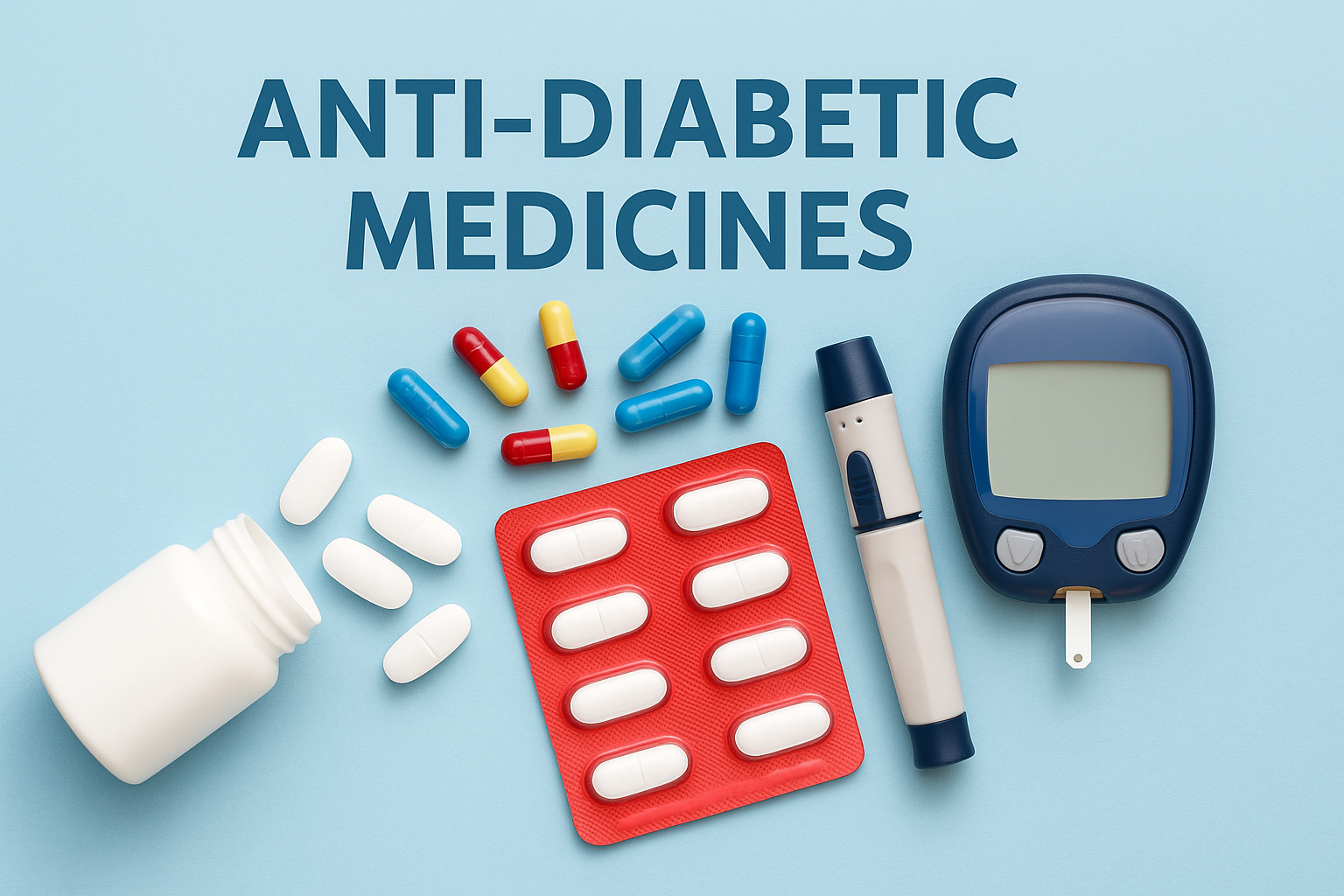Type 2 diabetes mellitus (T2DM) accounts for over 90% of diabetes cases globally and is characterized by impaired insulin action and progressive β-cell dysfunction. Long-term complications include cardiovascular disease, nephropathy, neuropathy, and retinopathy. While diet, exercise, and weight control remain foundational, pharmacologic agents are critical for glycemic control. The selection of appropriate therapy depends on patient-specific factors such as HbA1c levels, comorbidities, hypoglycemia risk, and drug tolerability.
 Classes of Anti-Diabetic Medicines for Type 2 Diabetes
Classes of Anti-Diabetic Medicines for Type 2 Diabetes
1. Biguanides
Drug: Metformin
Mechanism: Decreases hepatic gluconeogenesis and increases insulin sensitivity
First-line therapy due to efficacy, weight neutrality, and low risk of hypoglycemia
Example: Metformin hydrochloride
2. Sulfonylureas
Drugs: Glimepiride, Glipizide, Glyburide
Mechanism: Stimulate insulin secretion from pancreatic β-cells
Risk: Hypoglycemia and weight gain
Often used as second-line therapy
3. Thiazolidinediones (TZDs)
Drugs: Pioglitazone, Rosiglitazone
Mechanism: Improve peripheral insulin sensitivity via PPARγ activation
Cautions: Edema, heart failure risk, fracture risk
Pioglitazone also has favorable lipid effects
4. DPP-4 Inhibitors
Drugs: Sitagliptin, Saxagliptin, Linagliptin, Alogliptin
Mechanism: Inhibit degradation of incretin hormones (GLP-1, GIP), enhancing insulin secretion
Advantages: Oral, weight-neutral, low hypoglycemia risk
Used as monotherapy or add-on
5. SGLT2 Inhibitors
Drugs: Empagliflozin, Dapagliflozin, Canagliflozin, Ertugliflozin
Mechanism: Inhibit sodium-glucose co-transporter-2 in the renal tubules → glucosuria
Benefits: Weight loss, BP reduction, cardiovascular and renal protection
Cautions: Genital infections, volume depletion
6. GLP-1 Receptor Agonists (Injectable and Oral)
Drugs: Liraglutide, Semaglutide, Dulaglutide, Exenatide
Mechanism: Enhance glucose-dependent insulin secretion, delay gastric emptying, reduce appetite
Advantages: Weight loss, CV risk reduction
Semaglutide is now available in oral form
7. Alpha-Glucosidase Inhibitors
Drugs: Acarbose, Miglitol
Mechanism: Delay carbohydrate absorption in the small intestine
Main use: Postprandial hyperglycemia
Limitation: GI side effects (flatulence, diarrhea)
8. Meglitinides
Drugs: Repaglinide, Nateglinide
Mechanism: Stimulate rapid, short-duration insulin release
Use: Control of postprandial glucose spikes
Risk: Mild hypoglycemia
9. Fixed-Dose Combinations
Available as oral combinations to improve compliance and glycemic outcomes. Examples include:
Metformin + Sitagliptin
Metformin + Dapagliflozin
Glimepiride + Metformin
10. Insulin Therapy (When Required)
Though primarily used in Type 1 diabetes, insulin is also required in advanced T2DM or in cases of:
Severe hyperglycemia (HbA1c >10%)
Failure of oral therapy
Hospitalization or acute illness
Types include basal (long-acting), bolus (rapid-acting), or premixed insulin.
Current Guidelines & Therapeutic Trends
The American Diabetes Association (ADA) recommends:
Metformin as the first-line agent
Adding SGLT2 inhibitors or GLP-1 RAs in patients with cardiovascular disease, chronic kidney disease, or heart failure
Avoiding agents that promote weight gain or hypoglycemia when possible
Personalized therapy based on HbA1c targets, patient preferences, and cost considerations
Conclusion
The pharmacological armamentarium for T2DM has expanded significantly in the past decade. With newer agents offering cardiovascular and renal protection beyond glucose control, treatment can now be tailored to address individual comorbidities and improve long-term outcomes. A patient-centric approach, regular monitoring, and ongoing education are essential components of effective diabetes care.
